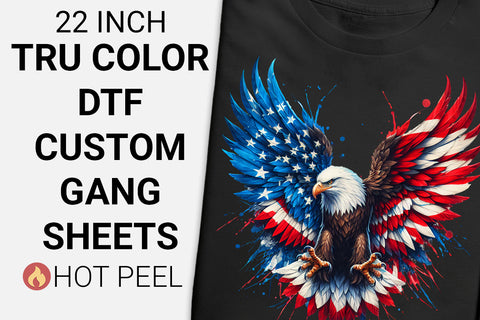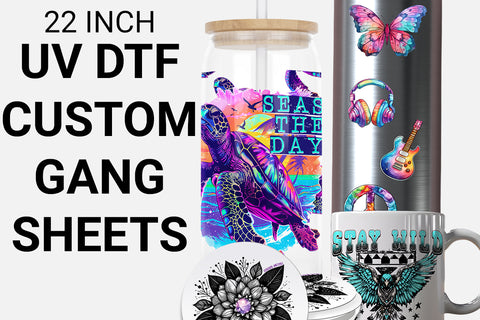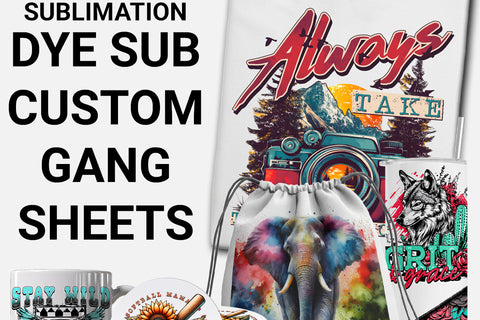If you are getting started with custom garment printing, you have likely come across the term DTF, or Direct-to-Film printing. DTF printing has quickly become one of the most versatile and cost-effective methods in the industry, especially for small business owners, hobbyists, and print-on-demand creators.
What makes DTF stand out is its flexibility. You can apply transfers to cotton, polyester, blends, and even dark fabrics. The prints are vibrant, durable, and feel soft to the touch. More importantly, the setup can be beginner-friendly if you take the time to understand the process.
This guide is written for anyone ready to create professional-grade DTF transfers at home or in a small studio. Whether you are testing your first designs or upgrading your apparel offerings, this step-by-step breakdown will help you get started with confidence.
What Is a DTF Transfer?
A DTF transfer is a heat-applied design printed using water-based DTF inks onto a PET film, then coated with a hot melt adhesive powder. Once cured, the transfer is pressed onto fabric using a heat press.
The key difference between DTF and other printing methods like DTG (Direct-to-Garment) or sublimation is that DTF does not require pre-treatment and can be used on a wider variety of fabrics, including cotton and dark-colored garments. Check our guide about DTF vs Screen Printing to know the main differences between the two.
This makes DTF an ideal solution for small production runs, personalization, and businesses looking for a lower entry barrier into professional textile printing.
Why Choose DTF Printing?
DTF printing offers several benefits that make it an increasingly popular choice:
-
Works on cotton, polyester, and blends
-
No pre-treatment needed
-
Excellent color vibrancy and sharpness
-
High durability (survives over 40 wash cycles when applied properly)
-
Allows for printing in bulk or on-demand
-
Ideal for full-color, detailed graphics
For new apparel decorators or print-on-demand sellers, DTF bridges the gap between affordability and quality. It requires less space than screen printing and less setup than DTG.
Equipment and Materials You Will Need
Before you can start producing DTF transfers, you will need the proper equipment and consumables. Investing in the right setup will help ensure print quality and consistency.
Required Tools and Supplies:
-
DTF printer (either a purpose-built printer or a converted inkjet model such as the Epson L1800 or XP-15000)
-
PET film sheets (preferably cold peel for beginner use)
-
DTF inks (white and CMYK colors formulated for textile printing)
-
Hot melt adhesive powder (also known as TPU powder)
-
RIP software (e.g., AcroRip or CADLink for color and ink control)
-
Heat press machine (with accurate time, temperature, and pressure settings)
-
Curing oven or hover press method
Optional tools may include a powder shaker, heat gun, or humidifier to maintain optimal room conditions.
Step-by-Step: How to Make a DTF Transfer
The following step-by-step guide outlines the full process of creating DTF transfers. Take your time with each stage to avoid common mistakes.
1. Prepare Your Artwork
Begin by creating or importing your design using software such as Adobe Illustrator, Photoshop, or Procreate. Make sure your image is high resolution and sized appropriately for your garment.
Design tips:
-
Use 300 DPI resolution for sharp detail
-
Keep the background transparent
-
Use RGB color mode (your RIP software will handle conversion)
-
Save as a PNG or TIFF file
Avoid low-resolution images or compressed file formats, as these can lead to pixelation during printing.
2. Process Your File in RIP Software
RIP software is responsible for managing ink output and layering, especially for printing the white underbase.
Key settings to configure:
-
Mirror the design before printing
-
Set correct ink limits to prevent bleeding
-
Enable white underbase for dark garments
-
Adjust the print resolution for the best quality
This stage is critical. Improper settings can result in blurry prints, poor color accuracy, or wasted film.
3. Print the Design on PET Film
Load the PET film into the printer, ensuring the printable side is facing the correct direction. Most films have a slightly textured side that accepts ink.
-
Print the color layer first, followed by the white ink layer
-
Allow the print to rest briefly before applying powder (do not let it fully dry)
Printing should be done in a clean, dust-free environment to prevent contamination of the film.
4. Apply the Hot Melt Adhesive Powder
While the ink is still slightly wet, apply the hot melt powder generously over the printed design. Tilt the sheet to distribute the powder evenly, ensuring full coverage over the inked areas.
-
Shake off excess powder
-
Avoid clumps or thin spots
Uneven powder coverage can lead to partial transfers or poor adhesion during pressing.
5. Cure the Powder
Once the powder is applied, it needs to be melted or “gelled” before the design can be transferred.
You have two main curing methods:
-
Curing oven: Heat at 300 to 320°F for 2 to 3 minutes
-
Heat press hover method: Hover the press over the film without contact for 2 to 3 minutes
The powder will melt into a smooth, slightly glossy surface. Be careful not to overheat, which can damage the film or cause bubbling.
6. Press the Transfer onto the Fabric
After curing, the transfer is ready to be applied to fabric. Pre-press the garment for a few seconds to remove moisture and wrinkles.
Pressing settings:
-
Temperature: 300 to 320°F
-
Time: 10 to 15 seconds
-
Pressure: Medium to firm
Allow the transfer to cool completely before peeling (cold peel). Then slowly and evenly remove the film.
Optional second press: Cover with a parchment sheet or Teflon and press again for 5 seconds to improve durability and finish.
Troubleshooting Common Issues
New users often encounter the same set of problems when getting started with DTF. Here are a few to watch for:
Issue: Colors look dull or washed out
Fix: Check RIP settings and ensure proper ink layering
Issue: Transfer peels off after washing
Fix: Powder was not cured properly or not enough pressure during pressing
Issue: Film sticks to the garment
Fix: Wait until the transfer is completely cool before peeling
Most issues are resolved by carefully reviewing curing times, heat press settings, and powder application.
How to Care for DTF-Printed Garments
DTF prints are designed to be durable, but proper care extends their life and keeps them looking sharp.
Recommended care instructions:
-
Wash inside-out in cold water
-
Use mild detergent
-
Tumble dry low or hang dry
-
Do not bleach
-
Do not iron directly on the print
Under normal use, DTF prints can last 40 or more washes with minimal fading.
Final Thoughts
DTF printing is a powerful and accessible method for producing high-quality, professional-grade garment designs. Whether you are printing t-shirts for your own brand, fulfilling custom orders, or exploring creative textile projects, learning how to make DTF transfers can expand your capabilities and streamline your workflow.
At DTF Virginia, we are dedicated to supporting creators at every stage of their printing journey. Our goal is to make complex printing methods simple, effective, and approachable, especially for those just getting started. With the right guidance and the right tools, anyone can produce high-impact apparel using DTF.


























